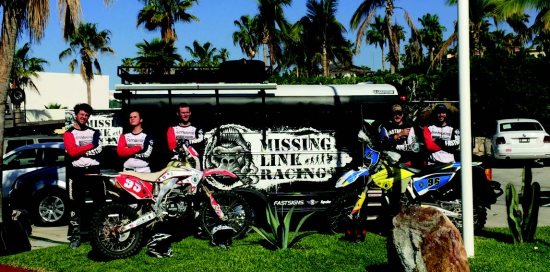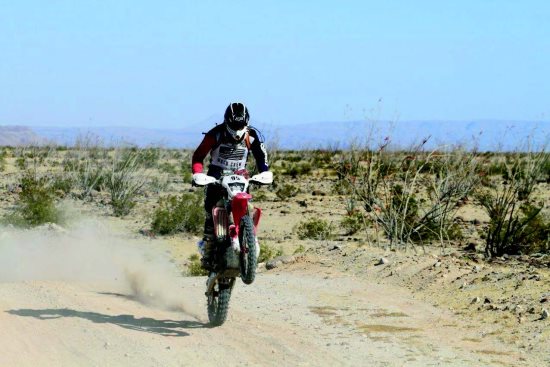
| ||||||
This past April, a dirt bike team, named The Missing Link, comprised primarily of Lamorinda riders, competed for the second year in a row in the Norra Mexican 1000 Rally. The race is a five-day affair in Baja, Mexico. Day one is a 200-mile ride from Ensenada to San Felipe; Day two is 280 miles from San Felipe to Guerrero Negro; Day three is 329 miles from Guerrero Negro to Loretto; Day four is 298 miles from Loretto to La Paz and Day five is 153 miles from La Paz to San Jose Del Cabo for a total of around 1,300 miles.
The Missing Link Race Team comprises six riders all of whom grew up in the Lamorinda area: Wesley Caspillo (24), Will McKay (21), Mitch Butler (23), Sterling Butler (19), Paul Jackson (26) and Nick Torchio (24). Like an auto racing team, it is also comprised of a crew team - Ron Bribes, Chris Butler, Kent Mc Kay, Scott Butler, Mark Tor- chio and Albert Caspillo.
Sally McKay whose son is a rider and whose husband is on the crew explained how it all began: "Scott Butler, who was a racer back in the 1980s, along with Mark Torchio and Albert Caspillo, wanted to reignite the fire and get the boys racing."
The first year the Missing Link team competed, they raced two bikes. This past year, they raced three bikes, though two of the bikes broke down during the race. The team also included two chase trucks, which carried the crew and the riders that were not riding and met up with the racers at each check point. Over such long distances, it was essential that the bikes be equipped with a GPS and the riders maintained constant radio contact with the crew.
The Norra Mexican 1000 is the only race in which the Missing Link competes in as all the competitors have full-time jobs or are in school. With all of the expenses involved - the bikes with all of their modifications, the crew bus, trailer, equipment and the admission fees - it costs about $10,000 per person the first year.
Many of these were one-time expenses, according to McKay: "After the first year, our major expenses were behind us. The second year, it primarily came down to the fees and the rooms and accommodations each night of the race."
There are several hundred riders involved in this race in various categories. With all of the time, effort and expenses that are invested in the race, what do the winning racers earn for their efforts? Says McKay: "The only prize is for first place and for that they receive a trophy."
There is in fact a professional circuit though the prize money is somewhat limited and the riders make most of their money through sponsorships and endorsements.
One doesn't just show up to ride about 600 miles over the desert. It does help that all of the riders have grown up on dirt bikes but there is a need to be in good condition. Says Mark Torchio, a member of the pit crew: "The riders have to be in good shape. They stand up most of the time on the pegs of the bikes. They are up and down on all types of surfaces. The kids do a lot of running and build up their cardio."
Besides the physical strain, there are other strains put on the riders, according to Torchio: "It's a mental thing as well. It can be very tiring mentally. When you are going as fast as 90 miles per hour, you really have to know what you're doing. There can be a wide range of injuries from broken bones to the rare fatality. The riders have to ride at a level they're comfortable with."
Will McKay has been a rider for the past two years and already sees a large improvement in their performance over their first year of competition: "We are riding now with more confidence. The first year we did not know what to expect and the second-year, things went a lot smoother in that we knew what to expect."
The more one rides in the race, the easier it gets, according to McKay: "It's knowing how to ride in the race and to make the bike work perfectly, knowing when to brake and when to hit the gas and how to make the turns. You become more comfortable reading the turns at a faster speed."
The people that put on the Norra Mexican 1000 race stress on their website the experience over a win at all costs mentality: " We have returned off-road motorsports to its roots - comradery, hot rodding and fun! The Mexican 1000 Rally is a fully-supported on-road/off-road rally open to vintage and modern vehicles. It is excitement-filled, with high-performance driving, incredible scenery and world-class adventure."
Torchio confirmed that these were not just words from a PR flak: "The Norra race is more of a fun thing. At the end of the day, we go to the hotel and have a big dinner and everyone talks about their day, besides working on their vehicles. There is great support among all the racers - if you break down, other racers will stop to see if you're okay. Baja is the last bastion of the wild West. Even though I'm not riding, when I get down there it re-energizes me. It's a landscape where you are on your own. You have to think your way out of situations."
Over such a long course, the pit crew is an essential part of the team. Says Torchio: "We run a bus as a rig for the crew along with another truck. We run down the highway and meet up with our riders when the course crisscrosses with the highway. We are in constant communication on radio with the riders and designate where we will meet them where we can check the tires and clean off the lenses, change the riders and fuel up the bikes."
Over the years the technology of the bikes has improved exponentially according to Torchio: "The quality of the bikes has come a long way. The suspension is better and the engines are now fuel injected. It's all electronically controlled. It's a small computer running the mechanics."
What is the true attraction of dirt bike riding. Torchio sums it up succinctly: "It's getting out in nature. It forces you to forget the daily nonsense. You have to focus 100 percent on what you're doing. You can't daydream or you will end up on the ground. It's not a draining focus. You live in the moment with the wind in your face as you are conquering new and complicated trails. It's a sense of accomplishment."

Reach the reporter at:
